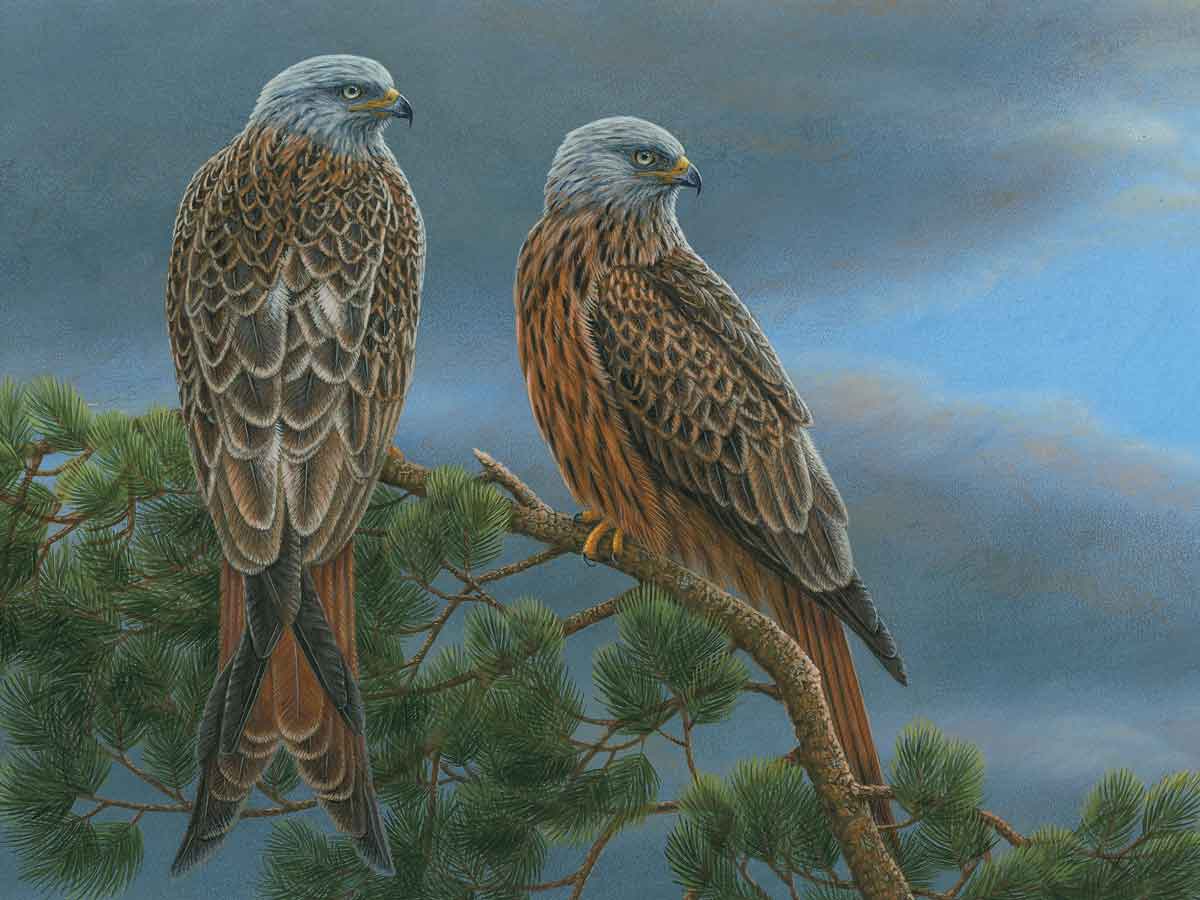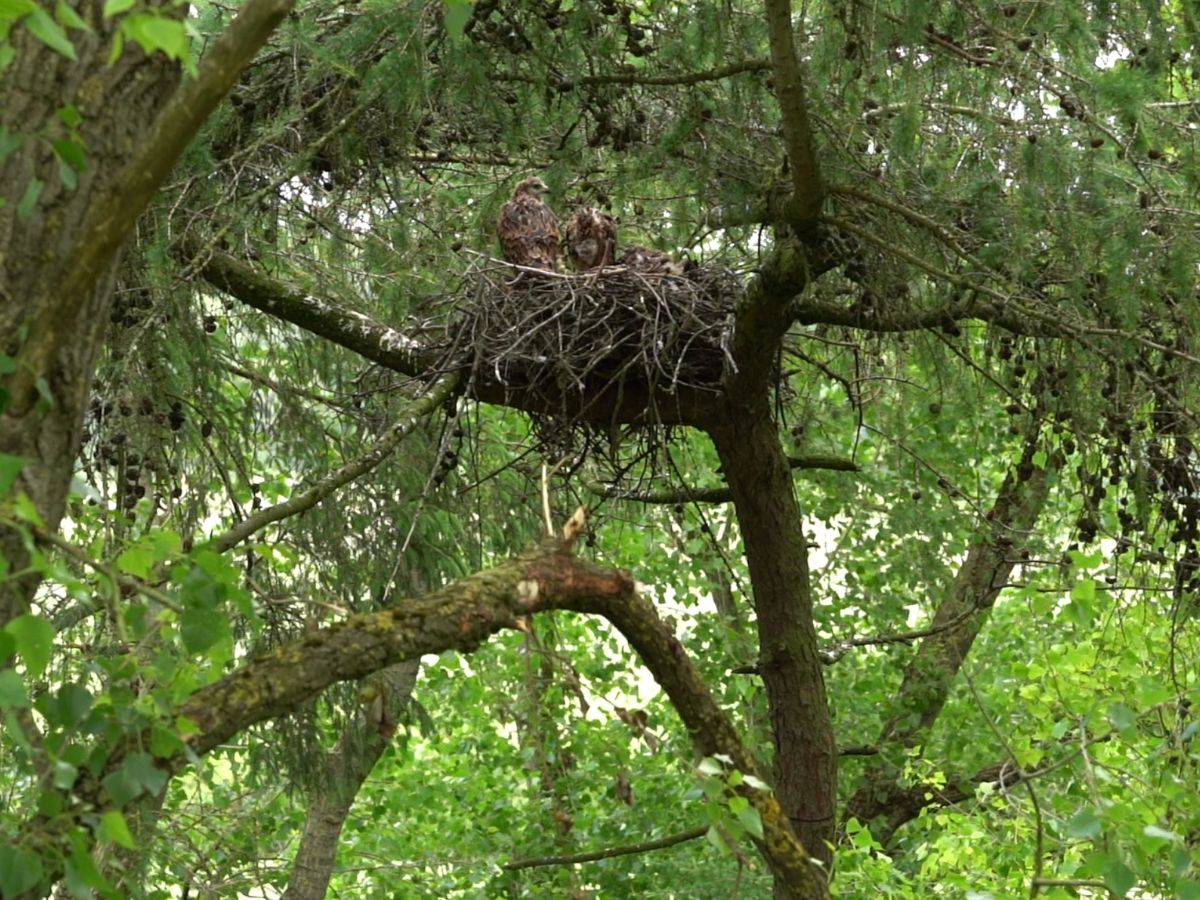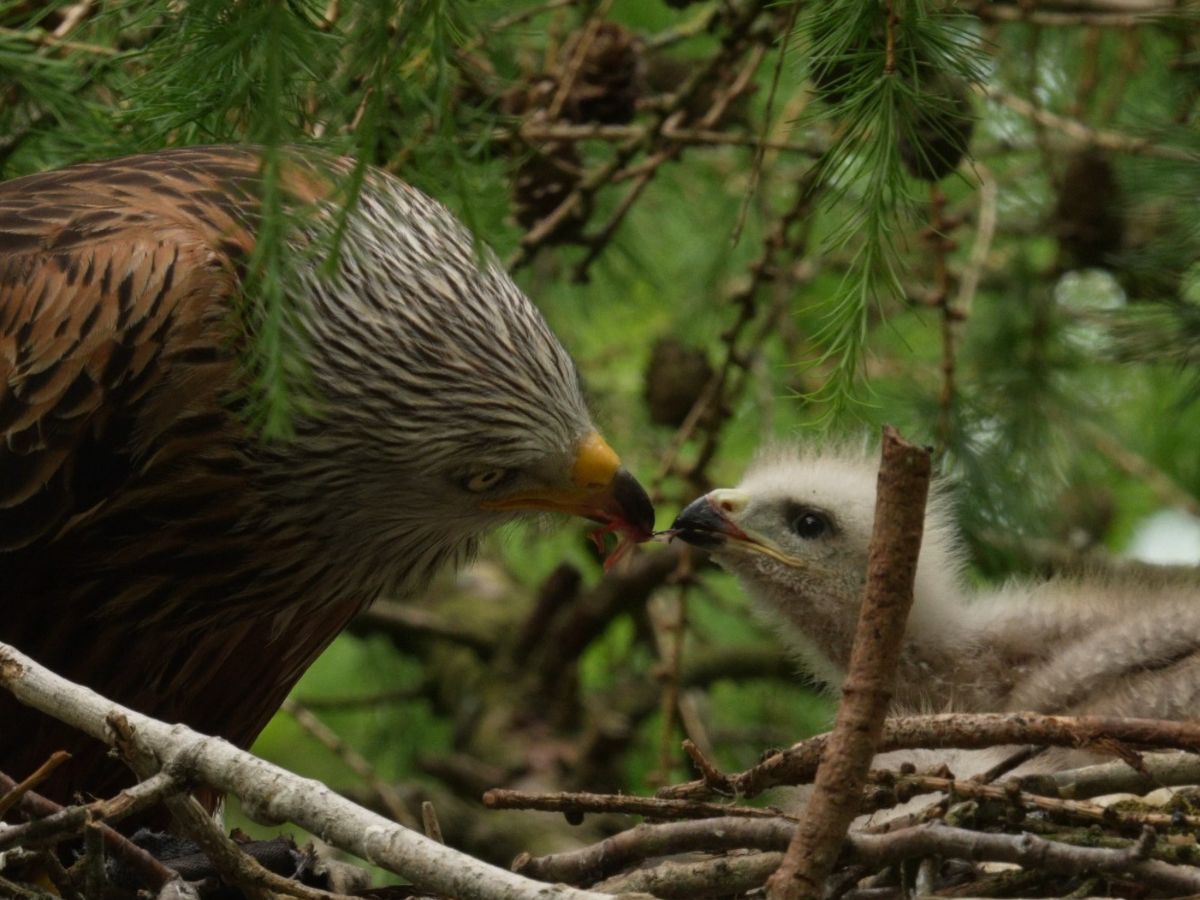Red kite painting
I’ve just finished a new painting of red kites. These beautiful birds of prey were a rare sight when I was growing up. There were just a handful of pairs in the whole country and none at all here in Yorkshire. But in the last 20 years have made an extraordinary comeback. And yet I still feel a thrill when I see one soaring in the skies above the Yorkshire Wolds.

Red kites’ lofty nests
So when I discovered a nest in the upper branches of a lofty larch tree, I got a special licence from Natural England to film the action up close. Red kites often use the same nest, adding more building material as they go and their nests can be huge. This one was enormous, a sign that the pair were established here.
That winter, with the nest empty, I came up with a plan to install remote cameras. I built a 15 metre scaffold tower to reach the nest. But once I was up there, I discovered heaps of rubbish inside. Red kites are known to scavenge odd bits to line their nests and I’ve heard of them collecting socks, flags, and even underwear. It’s not known if they do this to insulate the nest or purely for decoration.
But the plastic worried me, since it can make things damp. I cleared the litter before leaving, but over the course of this project the kites just kept on bringing in more. They weaved tissue paper, wet wipes, baler twine, pieces of rubble sacking and even a cardboard box into the nest. The most depressing thing of all was seeing them bring in the very latest type of litter: Covid masks.
Getting cameras to the nest
Once my cameras were safely installed, I dismantled my tower and then rebuilt it roughly 20 metres away, this time placing a hide at the top. It was so tall I had to concrete its base into the ground to protect it from strong winds. By the end of February all was ready and my remote cameras began to roll. For the next three months, I watched the action via monitors. By April the female red kite had laid three eggs, each one three days after the other. These were beautiful, white, speckled with dark chocolate-coloured flecks.
Surprise of male kite’s role
The male was surprisingly devoted. According to the textbooks, males are only known to help incubate eggs occasionally. But this one was taking turns to keep the eggs warm at least three times a day. The chicks hatched in early May and I watched on the monitors as the pair brought in food for them. Their diet consisted of rats, crows, rabbits, blackbirds, and even fish.
When the chicks were two weeks old, I climbed up to the hide for the first time. The chicks were now better at maintaining their body temperature and the adults were leaving them on their own for longer spells. When I arrived at the site there was no sign of either adult, but of course I couldn’t see much from so far down. I slowly climbed the tall tower of scaffold ladders, hauling my camera up behind me with a rope and pulley. I had brought a friend with me who I had asked to walk, pointedly, away once I was safely up. Most birds of prey can’t count and if the adult kites were watching I wanted them to think we had both now left.
Red kites up close
It wasn’t long before the female whooshed past the window of my hide. I sat motionless, peering expectantly down my camera lens for what felt like an hour. In fact it was only 15 minutes before a dark shape appeared at the back of the nest. This was the female kite. She paused for a moment to look at the end of my camera lens, which was now poking out of the hide.
Up close, her plumage was breathtaking. On her head and breast her feathers were diamond shaped, whereas the feathers on her wings were broader, a rich red-brown trimmed with lighter edging. I was transfixed. But then she turned her attention to her three hungry chicks and the moment of magic was gone.
Red kite chicks
She fed each in turn, doling out pieces of what looked like a blackbird carcass with dedicated attention. The chicks devoured it hungrily then started to call for more. She looked around the nest and found a left-over rabbit leg. I was surprised to see her offer them a bone that size, but after watching them struggle she then retrieved it and began to tear bite sized bits of flesh from it to feed to them.
After the chicks had had their fill, the female stood guard at the edge of the nest. It was amazing to see how alert she was to any movement and when a buzzard flew too close she plummeted off the side of the nest in pursuit. As she fell to the ground, she subtly adjusted the position of her wings and tail and then began to rise up through the canopy at considerable speed. Quickly she out-maneuvered the buzzard and chased it from her territory.
Tough lessons for chicks
As they grew, it was interesting to see how the parent birds gradually encouraged the chicks to become independent. It began with the female withdrawing her help at mealtimes.Over time, she would simply drop the food with them as if to encourage them to feed themselves. Once, I watched her wait a full 22 minutes as the two oldest chicks attempted to tear the flesh from a rat she had brought them, before finally taking over. As this happened, the chicks became more competitive, squabbling and pecking out at one another.
Time to fly
By around a month old, the chicks’ feathers begin to emerge along the back of their wings. Soon they could stand and flap their wings, comically knocking one another over as they did so. Then the day arrived when I got to the nest and found just two kite chicks. A short distance away, the third chick was high up in the conifer tree, having fledged earlier that morning.
It was a windy day, and the youngster lost its footing. It flew out of the wood and landed at the top of a large poplar tree. But the branches up there were so fine it soon tumbled upside down and lost its grip.
Red kite chicks’ first, tiring flights
Thankfully it landed on a thicker, sturdier branch lower down. Eventually it found its way to a branch close to the nest and sat quietly preening. As I watched its eyelids shuddered to a close, its head nodding backwards and forwards. I expect that first flight was exhausting.
The second chick also fledged that afternoon, but it was another four days before the final chick flew. By this point the adults had withdrawn all food deliveries, something they do to encourage chicks to fly.
Ready for life in the wild
However, the female was feeding one of the older siblings on a branch roughly 40 metres away. At the sight of this the youngest called out, protesting loudly, and then finally, and noisily, it took to the wing and joined its mother and sibling on the branch. But instead of offering it a reward, the female simply turned her back and flew away. To our eyes this seems harsh, but these birds need to be tough to survive in the wild.
Over the following few weeks, I continued to watch the chicks perfect their flying skills until they became quite accomplished. It was an amazing feeling to have spent nearly three months watching these young birds grow to adulthood and I couldn’t wait to begin my painting.







